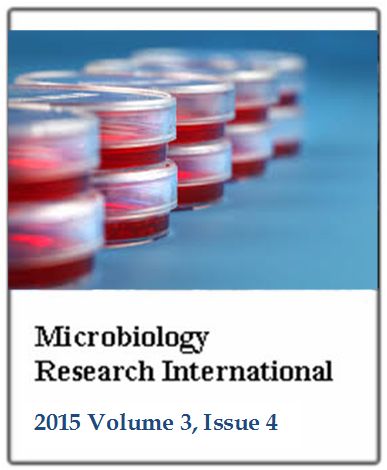Prevalence and antibiotic resistance patterns of strains of Staphylococcus aureus isolated at the Yaounde Military Hospital, Cameroon
Luria Leslie Njoungang, Julius Mbekem Nwobegahay, Celestin Roger Ayangma, Achiangia Patrick Njukeng, Michel Kengne, Emile Mbozo’o Abeng, Emmanuel Ambroise Mama, Mathieu Tchouamo and Daniel Ter GoonMicrobiology Research International
Published: October 27 2015
Volume 3, Issue 4
Pages 56-63
Abstract
Staphylococcus aureus is a ubiquitous pathogen involved in various pathologies. It has become a health problem worldwide due to the emergence of multidrug-resistant strains. This study was conducted to determine the prevalence and resistance patterns of S. aureus isolates from clinical specimens at the Yaounde Military Hospital, Cameroon. A total of 201 specimens were collected from both in and outpatients during a period of 6 months (June to December, 2013). Antibiotic drug susceptibility testing was performed using the disk diffusion method of Kirby-Bauer, according to the recommendations of the French Society of Microbiology. Data was analyzed using SPSS version 17. A total of 39 strains of S. aureus were isolated from various clinical specimens; 28 (72%) were resistant to methicillin. The results showed that all (100%) MRSA strains were multidrug resistant (resistance to one or more antibiotics classes), with 18 different resistance patterns. High resistance was recorded for penicillin (100%), cefoxitin (100%), doxycycline (61%), ofloxacin (50%), and erythromycin (50%). In contrast, the strains showed a high sensitivity to vancomycin (100%), pristinamycin (100%), followed by gentamicin (68%), netilmicin (68 %) and lincomycin (61%). Also, one wild type (susceptible to all antibiotics tested) was identified, suggesting that a rational drugs use could reduce the threat posed by the emergence of antimicrobial resistance. This study has highlighted the large number of staphylococcal infections; especially MRSA phenotype. There is an urgent need to monitor S. aureus to develop therapeutic guidelines for better treatment and to implement antimicrobial stewardship programs in communities as well as in hospitals.
Keywords: Prevalence, Staphylococcus aureus, antibiotics, resistance, MRSA.
Full Text PDF
